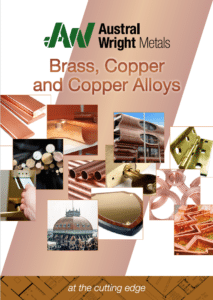Introduction to Copper
 |
Application Data Sheet – Copper Alloys |
Copper and copper alloys are one of the major groups of commercial metals. They offer a wide range of properties, including excellent electrical and thermal conductivity, outstanding corrosion resistance, good strength and fatigue resistance, and appearance. They can be readily worked, brazed and welded. Primary selection criteria include:
Many of the alloys are solid solution strengthened, but are based on the copper crystal structure and have good ductility. Most alloys can be further strengthened by cold work, which improves tensile and fatigue strength while retaining useful ductility. Some alloys can be dispersion strengthened, and a few can be age hardened to very high strength levels. The metals are commonly divided into six families: coppers, high copper alloys, brasses, bronzes copper nickels, and nickel silvers. Most alloys are available in the wrought or the cast condition, with different UNS numbers. 1. Coppers are essentially commercially pure copper, which ordinarily is very soft and ductile, containing up to about 0.7% total impurities. These materials are used for their electrical and thermal conductivity, corrosion resistance, appearance and colour, and ease of working. They have the highest conductivity of the engineering metals and are very ductile and easy to braze, and generally to weld. Typical applications include electrical wiring and fittings, busbars, heat exchangers, roofs, wall cladding, tubes for water, air and process equipment. 2. High copper alloys contain small amounts of various alloying elements such as beryllium, chromium, zirconium, tin, silver, sulphur or iron. These elements modify one or more of the basic properties of copper, such as strength, creep resistance, machinability or weldability. Most of the uses are similar to those given above for coppers, but the conditions of application are more extreme. 3. Brasses are copper zinc alloys containing up to about 45% zinc, with possibly small additions of lead for machinability, and tin for strength. Copper zinc alloys are single phase up to about 37% zinc in the wrought condition. The single phase alloys have excellent ductility, and are often used in the cold worked condition for better strength. Alloys with more than about 37% zinc are dual phase, and have even higher strength, but limited ductility at room temperature compared to the single phase alloys. The dual phase brasses are usually cast or hot worked. Typical uses for brasses are architecture, drawn & spun containers and components, radiator cores and tanks, electrical terminals, plugs and lamp fittings, locks, door handles, name plates, plumbers hardware, fasteners, cartridge cases, cylinder liners for pumps. 4. Bronzes are alloys of copper with tin, plus at least one of phosphorus, aluminium, silicon, manganese and nickel. These alloys can achieve high strengths, combined with good corrosion resistance. They are used for springs and fixtures, metal forming dies, bearings, bushes, terminals, contacts and connectors, architectural fittings and features. The use of cast bronze for statuary is well known. 5. Copper nickels are alloys of copper with nickel, with a small amount of iron and sometimes other minor alloying additions such as chromium or tin. The alloys have outstanding corrosion resistance in waters, and are used extensively in sea water applications such as heat exchangers, condensers, pumps and piping systems, sheathing for boat hulls. 6. Nickel silvers contain 55 – 65% copper alloyed with nickel and zinc, and sometimes an addition of lead to promote machinability. These alloys get their misleading name from their appearance, which is similar to pure silver, although they contain no addition of silver. They are used for jewellery and name plates and as a base for silver plate (EPNS), as springs, fasteners, coins, keys and camera parts. Classification of Wrought Copper Alloys
Classification of Cast Copper Alloys
Alloy designations: Alloys are available according to several numbering systems, including AS, UNS, BS, JIS and others as required. Individual alloy data sheets give alloy equivalents. Download Our Full Brass, Copper & Copper Alloys Catalogue
|
| The technical advice and recommendations made in this Product Data Sheet should not be relied or acted upon without conducting your own further investigations, including corrosion exposure tests where needed. Please consult current editions of standards for design properties. Austral Wright Metals assumes no liability in connection with the information in this Product Data Sheet. Austral Wright Metals supplies a comprehensive range of stainless steels, copper alloys, nickel alloys and other high performance metals for challenging service conditions. Our engineers and metallurgists will be pleased to provide further data and applications advice. |

